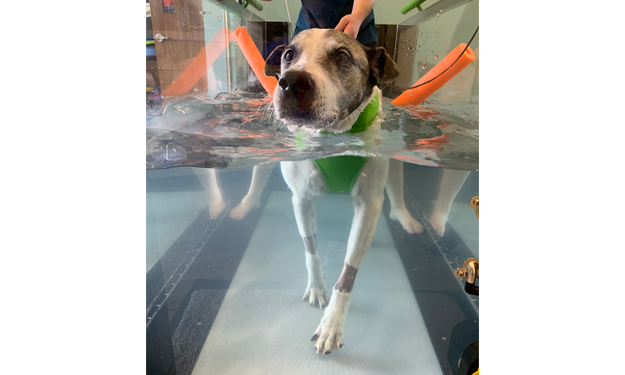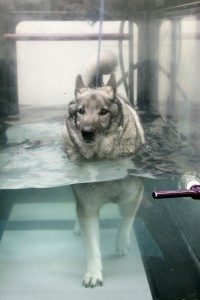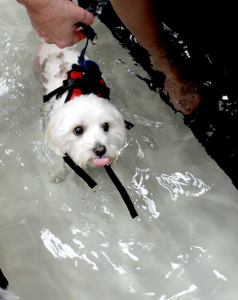How Treadmills Are Used in Veterinary Medicine

Treadmills are used in the veterinary physical therapy and rehabilitation world to encourage the patient to redevelop their gait and body position while walking. While a person can be asked to bear weight on a post surgical limb, a dog or a cat will compensate in order to avoid pain.
Two types of treadmills are used in veterinary sports medicine and rehabilitation: the conventional treadmill and the underwater treadmill. Each is used for a different function and to encourage different activities.
Your sports medicine team will work with you to ensure all exercises, even those you may be performing at home with your pet, are conducted in a safe and carefully monitored environment. As with human physical therapy, a slow and steady recovery is the best approach to long term success.
How do you use a conventional treadmill when working with dogs and cats?
In veterinary sports medicine and rehabilitation conventional treadmills are used to improve gait characteristics and to promote weight bearing following surgery or injury. The treadmill challenges balance, sense of leg position and coordination for the patient, thereby helping to normalize hip and knee range of motion.
If a patient has sustained an injury to either the hip or the knee, or has had surgery to either joint, exercising the pet in a safe and supervised environment on a conventional treadmill can be very well tolerated and effective.
- The treadmill is set to a prescribed speed, and the physical therapist, rehabilitation therapist, or veterinary technician monitors every aspect of the process with a critical eye to continued safety and gait.
- The treadmill moves beneath the patient, extending the hindlimbs farther than a painful patient would in a normal walking environment.
- In order to avoid pain, animals, as with people, will adjust their gait characteristics to compensate. The treadmill encourages walking, by shifting the ground beneath their feet.
- The movement of the treadmill prompts patients to use their joints and limbs, thereby normalizing their gait and exercising the recovering limbs.
What is an underwater treadmill, how does it work?
An underwater treadmill is a self-contained unit allowing for buoyancy and resistance training while walking on a treadmill submerged in 80 – 84 degree water.
The unit itself is comprised of:
- a treadmill section,
- a water storage tank
- and a filtration unit
The dog (or cat, if they are comfortable in water) walks into the dry treadmill unit with the therapist, the door is closed behind and water enters the chamber to the desired depth and buoyancy. Depending on the size of the patient this can take from thirty seconds to two minutes. The treadmill is turned on and your dog or cat walks for a prescribed time and speed, both of which are based the patient’s rehabilitation needs.
Following the aquatic therapy session, the water is drained, the dog (or cat) and the therapist leave the treadmill and the patient is towel or blow dried.
What are the unique benefits of Hydrotherapy and the underwater treadmill?
Combining the properties of water and exercise in a controlled environment allow for a number of wide-ranging benefits.
- Uses the properties of water to aid in healing
- Buoyancy: helps support the animal’s weight (less stress of healing bones/joints and less stress on arthritic joints)
- Resistance: to build muscle mass, improve cardiovascular health, help with weight loss
- Temperature: warm water helps circulation and keeps muscles warm during exercise
- Hydrostatic pressure: can help with blood flow and reduce swelling
- “Low impact, high resistance” exercise therapy
Used in treatment of:
- Post-operative reconditioning, strengthening and endurance
- Weight-loss
- Conditioning for pets, sporting dogs, and working dogs.
- Osteoarthritis management
- Neurologic disabilities – can be used for conservative disease/condition management or for post-operative care
- Orthopedic conditions – can be used for conservative disease/condition management or for post-operative care
Common conditions that utilize Hydrotherapy:
- Cranial Cruciate Ligament Repairs (TPLO, TTA, Lateral Suture Extracapsular repair)
- Medial or Lateral Patellar Luxation Repair
- Elbow and Shoulder Arthroscopies
- Hip (Femoral Head Ostectomy, Hip Luxation management, Total Hip Replacements, Hip dysplasia)
- Neurologic surgeries of the cervical, thoracic, and lumbar spine
- Osteoarthritis
- Weight loss
- Certain fractures and other orthopedic diseases
Benefits of the underwater treadmill include the following:
- Facilitates earlier return to function
- Unloads painful or arthritic weight-bearing joints
- Reduces joint compression
- Decreases swelling in submerged body parts with hydrostatic pressure
- Builds muscle mass
- Provides a safe, controlled environment to exercise
- Re-educates nerves and muscles
- Improves balance and proprioception